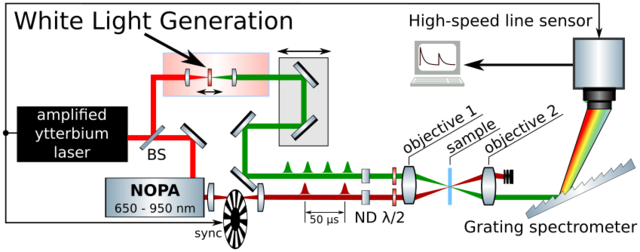Master's Thesis: Implementing White Light Probe in Femtosecond Transient Absorption Microscope
Our group is looking for a highly motivated Master student who is interested in extending our transient absorption microscope (TAM) setup to wavelength-resolved detection using white light generation, a highly nonlinear process in crystals. Together with PhD student Robert Schwarzl, the student will implement a high-speed grating spectrometer and a white light generation beam path.
TAM is a state-of-the-art spectroscopy technique, providing femtosecond temporal and (sub-)micrometer spatial resolution. It allows tracking the flow of energy and charges in real time in novel materials like quantum dots, plasmonic structures, or organic thin films. Using femtosecond lasers, the method is able to observe processes at least three orders of magnitude faster than the best electrical components. The extension towards white-light probe will allow us to perform a full-range material characterization in a matter of minutes instead of weeks.
Master's Thesis: Characterization of Higher Excitons in Squaraines using Femtosecond Transient Absorption Microscopy

Our group is looking for a highly motivated Master student who is interested in investigating a class of organic semiconductors called Squaraines. Together with PhD student Robert Schwarzl, the student will perform time-, space- and polarization-resolved measurements of the molecular crystals using femtosecond laser pulses. Results will be discussed with collaborators in Graz, Linz and Philadelphia.
Due to extraordinarily strong intermolecular coupling, squaraines have a fascinating structure-function relationship leading to changes in their exciton absorption spectra known as \emph{Davydov splitting}. Collective, higher molecular excitations which elude more traditional spectroscopic methods will be investigated using the ultrafast technique Femtosecond Transient Absorption Microscopy (TAM). The method allows us to achieve (sub-)micrometer spatial resolution and femtosecond temporal resolution, two crucial aspects for the highly anisotropic materials with picosecond excitation lifetimes.
